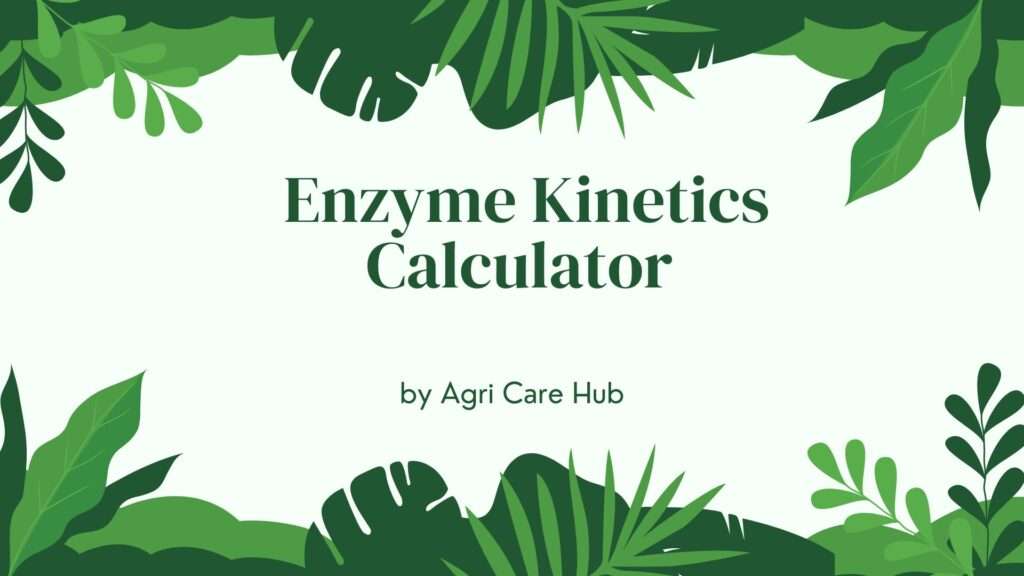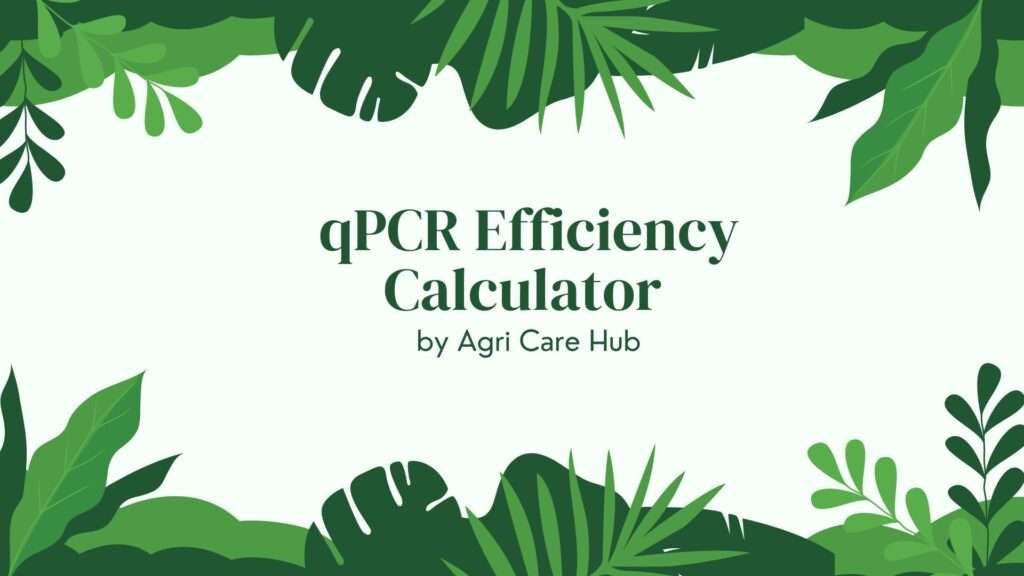Competitive Inhibition Calculator
Calculate Enzyme Kinetics
Results
About the Competitive Inhibition Calculator
The Competitive Inhibition Calculator is a powerful tool designed to help researchers, students, and professionals in biochemistry and related fields analyze enzyme kinetics under competitive inhibition conditions. Built on the principles of Michaelis-Menten kinetics, this calculator provides accurate calculations of reaction velocity and apparent Km, enabling users to understand how inhibitors affect enzyme activity. Whether you're studying enzyme behavior or designing experiments, this tool, supported by resources like Agri Care Hub, ensures reliable results based on peer-reviewed scientific methodologies.
Importance of the Competitive Inhibition Calculator
Enzyme kinetics is a cornerstone of biochemistry, and understanding competitive inhibition is critical for applications in drug design, agriculture, and biotechnology. Competitive inhibitors bind to the active site of an enzyme, competing with the substrate and affecting the enzyme's efficiency. This calculator simplifies complex calculations, allowing users to input key parameters like Vmax, Km, substrate concentration, inhibitor concentration, and inhibition constant (Ki) to obtain precise results. By providing instant insights, the tool saves time and enhances experimental accuracy.
What is Competitive Inhibition?
Competitive inhibition occurs when an inhibitor molecule mimics the substrate and binds reversibly to the enzyme's active site, preventing the substrate from binding. This increases the apparent Km (Michaelis constant) without affecting Vmax. The Non-Competitive Inhibition page on Wikipedia provides a contrasting mechanism, where inhibitors bind to a different site. Our calculator focuses on competitive inhibition, using the modified Michaelis-Menten equation: v = Vmax [S] / (Km (1 + [I]/Ki) + [S]), ensuring scientifically accurate outputs.
Purpose of the Competitive Inhibition Calculator
The primary purpose of this calculator is to provide a user-friendly interface for calculating enzyme reaction rates under competitive inhibition. It is designed for:
- Researchers: To analyze enzyme kinetics in experimental settings.
- Students: To learn and apply concepts of enzyme inhibition in biochemistry courses.
- Professionals: To optimize processes in industries like pharmaceuticals and agriculture, where enzyme activity is critical.
- Educators: To demonstrate the effects of competitive inhibitors in a classroom setting.
By integrating this tool into your workflow, you can make informed decisions based on precise kinetic data.
Why Use the Competitive Inhibition Calculator?
Understanding enzyme inhibition is essential for developing effective drugs, improving agricultural yields, and advancing biotechnological innovations. This calculator offers several benefits:
- Accuracy: Calculations are based on the Michaelis-Menten model, ensuring reliable results.
- Ease of Use: A clean interface with clear input fields and instant results enhances user experience.
- Time-Saving: Automates complex calculations, reducing manual errors.
- Educational Value: Helps users visualize the impact of inhibitors on enzyme kinetics.
Whether you're exploring enzyme behavior or optimizing industrial processes, this tool is a valuable asset.
When to Use the Competitive Inhibition Calculator
This calculator is ideal for various scenarios, including:
- Drug Development: To study how potential inhibitors affect enzyme activity, aiding in the design of targeted therapies.
- Agricultural Research: To optimize enzyme-based processes in pesticide or fertilizer development.
- Academic Studies: To support coursework or research in biochemistry and molecular biology.
- Biotechnology: To fine-tune enzyme performance in industrial applications.
Use this tool whenever you need to quantify the effects of a competitive inhibitor on enzyme kinetics.
User Guidelines
To ensure accurate results, follow these steps:
- Input Vmax: Enter the maximum reaction rate (µmol/s) of the enzyme without inhibition.
- Input Km: Provide the Michaelis constant (mM), which indicates the substrate concentration at half Vmax.
- Input Substrate Concentration [S]: Enter the concentration of the substrate (mM).
- Input Inhibitor Concentration [I]: Specify the concentration of the competitive inhibitor (mM).
- Input Ki: Enter the inhibition constant (mM), which reflects the inhibitor's binding affinity.
- Calculate: Click the "Calculate" button to view the reaction velocity and apparent Km.
Ensure all inputs are positive numbers to avoid errors. The results will display the reaction velocity (v) and the apparent Km, adjusted for the inhibitor's presence.
Scientific Basis of the Calculator
The Competitive Inhibition Calculator is grounded in the Michaelis-Menten equation, modified for competitive inhibition. The standard Michaelis-Menten equation is:
v = Vmax [S] / (Km + [S])
In competitive inhibition, the inhibitor increases the apparent Km, resulting in the modified equation:
v = Vmax [S] / (Km (1 + [I]/Ki) + [S])
Where:
- v = Reaction velocity (µmol/s)
- Vmax = Maximum reaction rate (µmol/s)
- [S] = Substrate concentration (mM)
- Km = Michaelis constant (mM)
- [I] = Inhibitor concentration (mM)
- Ki = Inhibition constant (mM)
This formula accounts for the competitive inhibitor's effect on the enzyme's substrate affinity, providing a precise measure of reaction kinetics.
Applications in Real-World Scenarios
The calculator has broad applications across multiple fields:
- Pharmaceuticals: Competitive inhibitors are often used in drug design to target specific enzymes, such as in the development of antibiotics or antivirals.
- Agriculture: Understanding enzyme inhibition helps optimize pesticide formulations, as seen in resources provided by Agri Care Hub.
- Education: Students and educators can use the tool to explore enzyme kinetics in a hands-on way.
- Research: Researchers can quantify inhibitor effects to guide experimental design.
By providing accurate calculations, the tool supports innovation and discovery in these fields.
Limitations and Considerations
While the Competitive Inhibition Calculator is highly accurate, users should be aware of its limitations:
- It assumes steady-state kinetics and competitive inhibition only, not non-competitive or uncompetitive inhibition.
- Inputs must be based on experimental data for meaningful results.
- The calculator does not account for complex multi-substrate reactions or allosteric effects.
For non-competitive inhibition scenarios, refer to the Non-Competitive Inhibition page for more details.
Conclusion
The Competitive Inhibition Calculator is an essential tool for anyone studying or working with enzyme kinetics. Its user-friendly design, scientific accuracy, and practical applications make it a valuable resource for researchers, students, and professionals. By integrating this tool into your WordPress website, you provide your audience with a reliable way to explore competitive inhibition, supported by trusted resources like Agri Care Hub. Start using the calculator today to enhance your understanding of enzyme behavior!












